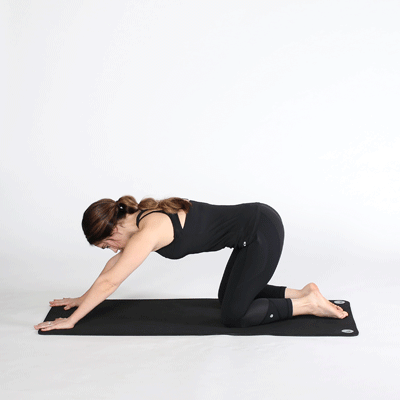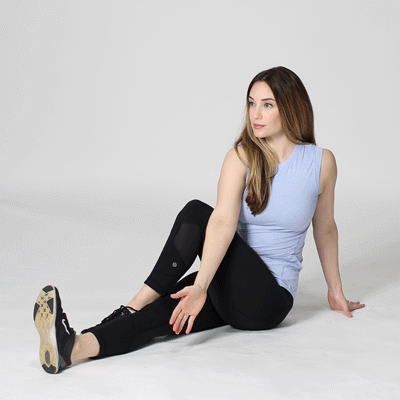Sitting for extended periods or general inactivity can lead to tightness in your hips. This may cause your hip muscles to become relaxed, weakened, and shortened.
Overusing your hips during activities such as cycling and running can also be a culprit. Other causes of tight hips include one leg that’s longer than the other, sleeping on only one side of the body, along with individual postural and structural imbalances.
All of these factors can cause limited range of motion, back pain, and muscular tension.
Over time, tight hips can lead to swelling and muscle tears, so it’s important to take time out to stretch your hips, especially if you already feel any tension or discomfort in this area.
1. Seated glute stretch
Breathe deeply during this stretch to relieve discomfort and improve hip mobility.
To do it:
- Sit in a chair with your knees bent, then place your right foot onto your left thigh.
- Hinge at your hips to fold your torso over your legs.
- Hold for 30 seconds to 1 minute.
- Perform on the opposite side by switching your top foot.
2. Child’s Pose
For extra support, place a cushion under your hips or thighs.
To do it:
- From all fours, bring both knees together or place them slightly wider than your hips.
- Sink your butt toward your heels as you lean forward, resting your forehead on the floor.
- Extend your arms in front of you.
- Hold this position for up to 3 minutes.
3. Seated Spinal Twist
This seated yoga pose not only opens tight hips, but it also strengthens your spinal mobility.
To do it:
- While seated, extend your right leg or place your right foot to the outside of your left buttock.
- Place your left hand to the outside of your right thigh.
- Inhale as you lengthen your spine.
- Exhale as you twist your torso to the right.
- Place your right hand on the floor behind you.
- Wrap your left arm around your leg or place your elbow to the outside of your knee. Gaze in any direction.
- Hold this position for up to 1 minute.
- Perform on the opposite side.
Lengthen and strengthen your hip flexors with these deep stretches, helping to counteract extended periods of sitting as well as tightness that comes from age and exercise.
4. Low Lunge
To do it:
- From Downward-Facing Dog, place your right foot in between your hands.
- Lower your left knee to the floor.
- Sink into your lower body as you lengthen up through your spine.
- Place your hands on the floor or extend them overhead.
- Hold for up to 1 minute.
- Perform on the opposite side.
5. Reclined Pigeon Pose
To do it:
- Lie on your back with your knees bent and your feet flat on the floor near your hips.
- Place the outside of your right ankle at the bottom of your left thigh.
- Raise your left foot to draw your knee in toward your chest.
- Interlace your fingers behind your thigh or shin.
- Hold for up to 1 minute.
- Perform on the opposite side.
6. Knee-to-chest
To do it:
- Lie on your back with your right knee drawn in toward your chest, placing your hands behind your thigh or at the top of your shinbone.
- Extend your left leg straight out or place your foot on the floor with your knee bent.
- Hold this position for up to 1 minute.
- Perform on the other side.
Your hip abductor muscles have a stabilizing effect on your body that helps you to stand, walk, and balance on one leg. You also use these muscles when you rotate your legs or move them away from your body.
7. Clamshell
Once you’ve mastered the basic clamshell, change up your routine with a few of these variations.
To do it:
- Lie on your left side, supporting your head with your hand.
- Stack your hips and legs with your knees bent at a 45-degree angle.
- Use your hip to open your right knee up.
- Hold this position for 3 seconds.
- Lower back down to the starting position.
- Do 1 to 3 sets of 10 to 20 repetitions on both sides.
8. Cow Face Pose
To do it:
- From a seated position, stack your right knee on top of your left knee, aligning both knees in toward the center of your hips.
- Tuck both feet in close to your buttocks.
- Hinge at your hips to slowly walk your hands forward, resting in any comfortable position.
- Stay in this position for up to 1 minute.
- Perform on the opposite side.
9. Standing leg raises
To do it:
- Stand with your right hand resting on the wall or a chair.
- Keep your hips facing forward as you lift your left leg to the side.
- Hold for 5 seconds.
- Slowly lower to the starting position.
- Do 8 to 15 repetitions then repeat on the opposite side.
These stretches will help to improve range of motion and reduce hypermobility in your hips that can occur as the result of weak hip stabilizers.
10. Happy Baby
If it’s challenging to reach your feet, place your hands on your thighs or lower legs, or use a strap around the tops of your feet.
To do it:
- Lie on your back with your knees bent in toward your chest and the soles of your feet facing up toward the ceiling.
- Place your hands on the outside of your feet.
- Create resistance by pressing the soles of your feet into your hands and pushing your feet and legs down toward the floor.
- Roll and press your lower back down into the mat.
- Hold this position for up to 1 minute.
11. Butterfly stretch
To do it:
- While seated, bend your knees and press the soles of your feet together.
- The further your feet are from your hips, the gentler the stretch.
- Interlace your fingers around the pinky toe side of your feet.
- Hold this position for up to 1 minute.
12. Low squat
For extra support, place a block or cushion under your hips.
To do it:
- From standing, slowly lower your hips to come into a low squat.
- If possible, press your heels into the floor.
- Walk your thighs out as you bring your palms together.
- Press your elbows into the insides of your knees as you lengthen your spine.
- Hold this position for up to 1 minute.
Pay attention to how your hips feel, especially if you’re noticing pain or tension in other parts of your body. The best way to prevent tight hips is to spend a bit of time each day stretching and strengthening your hips.
- Work on improving your mobility, stability, and flexibility while staying active through a wide range of activities.
- Give your hips some love by using a heating pad or ice on painful areas for 15 minutes at a time. You could also take a hot bath or visit a sauna.
- Book yourself a massage as often as possible and apply muscle rub to any areas of tension twice daily.
- Always warm up for a few minutes before beginning any physical activity and follow each session with a cool down.
- When sitting for long periods, get up for at least 5 minutes each hour and move around a bit. This helps to relieve tension, boost circulation, and reduce inflammation.
- Sleep on your back if possible and avoid sleeping only on one side. Sleeping on a soft mattress with a pillow between your knees may be more comfortable if you’re a side sleeper.
If you’re experiencing extreme pain or if any of your symptoms worsen, take a break from all activity and schedule an appointment with a doctor, physical therapist, or fitness professional.
For best results, maintain consistency and aim to do at least some stretching each day, even when you feel pressed for time. Use this as a chance to tune inward and relax your body and mind.
Balance the stretching with some strengthening exercises that will support your improved flexibility. Energy in motion tends to stay in motion, so make a point to get moving as often as possible.
The more often you set aside time to improve your mobility, the more likely you are to stay on track to meet your goals. Find out what keeps you motivated, and do whatever it takes to bring about positive changes.



